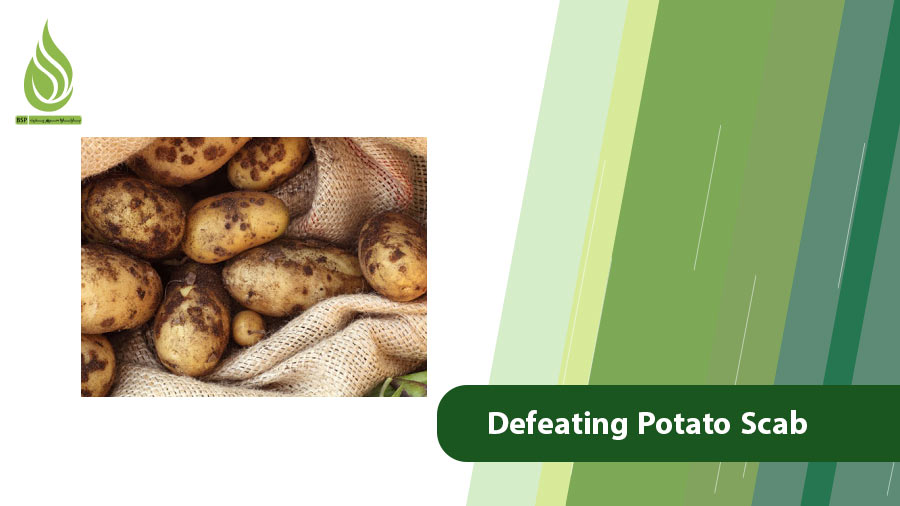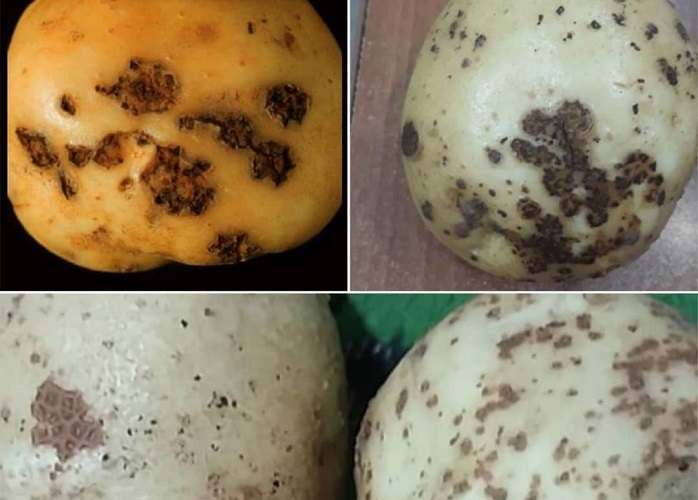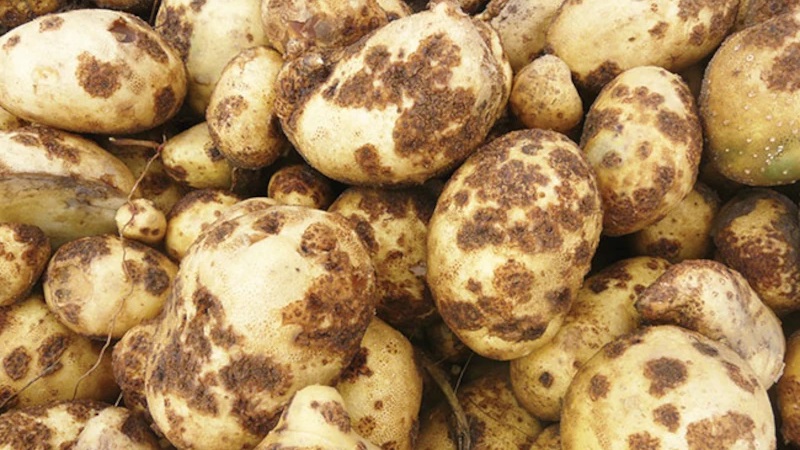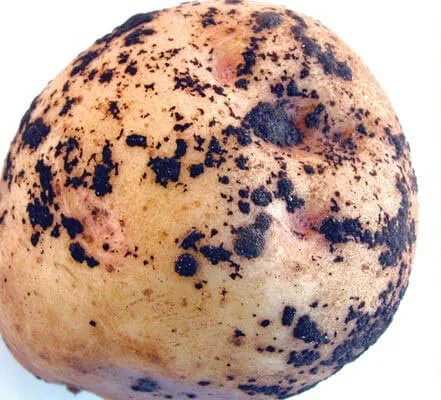
Defeating Potato Scab: Control, Treatments, and Prevention Guide
Potatoes hold a special position in the agricultural industry, being a staple in the food supply of many nations. Following wheat, corn, and rice, potatoes rank as the fourth most produced crop. Among the challenges faced by potato farmers is the prevalent issue of potato scab disease. While this disease doesn’t render potatoes unsafe for consumption, it significantly diminishes their visual appeal, impacting their market value. Farmers often find themselves compelled to sell scab-affected potatoes at discounted rates due to their compromised appearance.
Potato scab, scientifically known as Streptomyces scabies, manifests as necrotic lesions with a cork-like texture on the potato skin. These lesions can vary in depth and appearance, including a range of colors. The presence of pits and interconnected cracks on the tubers also serves as a telltale sign of scab infection. The damaged tissues of scab-affected potatoes attract various soil-dwelling organisms like millipedes and white worms, which can exacerbate the severity of scab lesions over time.

Apart from affecting potatoes, scabs can also be found in other root vegetables like beets, carrots, radishes, and turnips. In Iran, this condition goes by various names such as potato scab, potato scab, and pitted scab.
What are the signs of potato scab?
Potato scab disease presents itself in several ways:
- Cork Lesions: Also known as fluffy scab or superficial scab, cork lesions typically appear as tan or brown spots on potato tubers. These wounds are randomly distributed across the surface of the tuber and come in various sizes. In cases of superficial scab, these spots can merge to form larger patches on the potato, sometimes resulting in bumps or depressions.
- Deep or Cavity Scabs: This type of scab manifests as sunken craters in the center of the potato, varying in depth. The wounds are generally circular and typically range from 1 to 5 mm in diameter.
- Network Cracks: The presence of interconnected cracks is another indicator of potato scab disease.
Symptoms of scab can appear as early as the beginning of tuber growth or may remain hidden until harvest. If left unchecked, the effects of scab disease can persist on your produce for years, impacting its market value and quality.

What causes potato scab disease?
Potato scab is a bacterial infection that thrives as spring sets in and temperatures rise. The optimal temperature range for the development of this disease is typically between 19-24 degrees Celsius. However, some researchers suggest that the bacteria responsible for this disease can also proliferate at temperatures ranging from 10 to 31 degrees Celsius.
The primary culprit behind scab disease is the bacterium Streptomyces scabies, commonly found in the soil where potato, carrot, beet, radish, and other tuberous crops grow. To promote the growth of this bacterium, the soil pH needs to be above 5.5.
The primary factors contributing to scab infections include:
- Contaminated Soil: Contamination of the planting bed with scab-causing bacteria.
- Wind-Borne Spores: Infected spores carried by the wind to healthy crops.
- Contaminated Equipment: Use of agricultural machinery that carries scab-causing pathogens.
- Soil Conditions: Alkaline soil with high pH levels favors the growth of scab bacteria.
- Planting Timing: Interval between planting tuberous crops can influence susceptibility to scab.
- Soil Texture: Soils with light, sandy texture are prone to moisture loss, creating favorable conditions for scab development.
- Decaying Plant Matter: The presence of diseased plant residues in the soil can harbor scab pathogens.
- Manure Contamination: Use of animal manure contaminated with scab-causing agents.
- Weather Conditions: Hot and dry weather, particularly 2-5 weeks after tuber formation, increases the likelihood of scab infection.
Once the bacteria infiltrate the soil, it establishes a lasting presence, persisting year after year and impacting your crops unless managed effectively. The repercussions of scab aren’t limited to a single growing season; unresolved issues will lead to recurring outbreaks, affecting your harvest annually.
The Streptomyces bacterium spreads through various means such as spores, contaminated water, and soil, hitching rides on nematodes and insects. This bacterium gains entry into potato tubers through wounds. Upon infecting a plant, Streptomyces scab releases a phytotoxin called Thaxtomin, which dismantles cell walls and infiltrates developing cells. As infected potato cells perish, cork cells form and protrude, giving rise to scab lesions. These cork cells continue to multiply, leading to the formation of larger lesions. In certain potato varieties, scabs may manifest as pitted or raised lesions instead of corky formations.

Tips for Managing and Treating Potato Scab Disease
Opt for resistant potato varieties
Certain potato cultivars exhibit greater resistance to scab disease, offering a proactive defense against infections. Varieties with rougher skin textures tend to be more resilient. Choosing cultivars that are well-suited to your region can also play a crucial role in warding off scab disease. By selecting potatoes known for their resistance, you can take a significant step towards safeguarding your crop from this troublesome affliction.
Avoid Consecutive Cultivation of Tuberous Crops
It’s advisable to refrain from planting tuberous crops in soil harboring Streptomyces scabies bacteria to prevent a surge in bacterial populations. Continuously planting potatoes can significantly amplify the presence of these harmful bacteria, affecting not only potatoes but also other tuberous crops like sugar beets, carrots, and turnips. To combat and eradicate this bacterial threat, it’s recommended to rotate potato crops with different plants such as alfalfa, wheat, or corn in alternate years.
An optimal crop rotation cycle spans four years, allowing for potato planting in the same field once every four years to effectively manage scabies. If potatoes are your primary crop, consider shifting to a new field annually to mitigate the risk of infection. Renting land for potato cultivation offers a practical solution, enabling you to sow your crop in fresh soil each year. However, ensure the new plot is free from scab contamination by verifying the crop history of the land over the past five years. This proactive approach can help safeguard your potato harvest from the persistent threat of scab disease.
Maintaining Soil pH to Combat Potato Scab Disease
Potato scab disease thrives in alkaline soil environments. Regulating soil pH levels is key to eradicating scab infections. To effectively manage this disease, it’s essential to maintain soil pH within the range of 3.5 to 5. Introducing sulfur-based fertilizers that acidify the soil proves highly effective in preventing potato scab.
When aiming to lower soil pH, exercise caution when using chemical fertilizers. Certain nitrogen-based fertilizers have the potential to elevate soil pH levels. Given that nitrogen is crucial for plant development, opting for acidic alternatives like ammonium sulfate becomes vital. This fertilizer not only supplies necessary nitrogen to plants but also contributes to soil acidification due to its sulfur content. Additionally, sulfuric acid-based fertilizers can effectively lower soil pH levels.
When selecting fertilizers, prioritize their acidity or alkalinity levels and tailor your fertilization practices accordingly to maintain optimal soil pH conditions. By carefully managing soil amendments and choosing acidic fertilizers, you can create an environment unfavorable for potato scab development, thus safeguarding your crop yield.
Steer Clear of Animal Manure
Using animal manures like chicken manure and other livestock byproducts can heighten soil contamination with scab-causing bacteria. To minimize this risk, it’s advisable to limit the application of animal manure in such soils, especially if you intend to grow tuberous crops. Additionally, refrain from incorporating calcareous materials into scab-prone soil. Instead, opt for alternatives like liquid sulfur and compost.
Compost production involves a thermal process that eliminates pathogenic agents, making compost a safe option that does not contribute to scab development. By sidestepping animal manure and employing suitable substitutes like compost and liquid sulfur, you can effectively manage soil health and mitigate the risk of scab infection in your crops.
Combat Potato Scab Disease Through Proper Soil Moisture Management
Maintaining optimal soil moisture levels is pivotal in eradicating potato scab disease. Heat and aridity serve as catalysts for scab proliferation. Scab thrives in temperatures exceeding 21°C with soil humidity below 65%. The period spanning 2 to 5 weeks post-tuber formation is critical for potato crops. Warm and dry conditions during this phase create an inviting environment for bacterial attacks. To thwart scab development, it’s essential to ensure the soil remains adequately moist during the second to fifth weeks after planting, with soil moisture levels ideally ranging between 80% to 85%.
Seeking guidance from a seasoned agronomist is advisable to pinpoint the optimal irrigation schedule. Considering factors such as soil composition (light or heavy) and local weather patterns, an expert can prescribe the most suitable irrigation timing for your potato fields. By fine-tuning your irrigation practices based on professional recommendations, you can effectively regulate soil moisture levels and fortify your crops against the scourge of potato scab disease.
Use of fungicide
One of the ways to control scabies is to use fungicides that prevent scabies. For this purpose, different brands of fungicides and pesticides have offered products. Usually, the method of using fungicides is that the fungicide is applied to plants or the soil in two or more stages. Depending on the characteristics of the fungicide, one or more stages of these products should be used to control the disease well. Sulfur-containing fertilizers can also be used to control pests. The effect of sulfur fertilizer on pest control can prevent potato scab.
To get the best results in the control and treatment of scabies, it is better to do several of the above methods in combination. For example, using a fungicide along with maintaining soil moisture and planting a scab-resistant species will have better results than a single method.